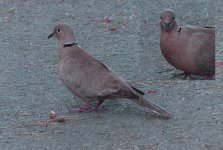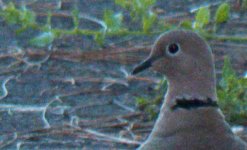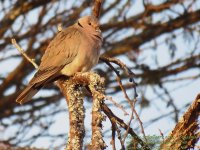Hi,
while at Costa Calma, Fuerteventura, 12th of March, I encountered this dove at the middle section of the 'Costa Calma Woodland', the planted woods long the coastal highway. It probably still is there, if alive, as there are limited sources of food and water in the area.
To me, it looks like a good candidate for a Vinaceous Dove, based on 1) structure in comparison to a Eurasian Collared Dove which tried to court it (smaller, plumper, clearly not as elongated), 2) vinaceous/brownish overall color, particularly breast, 3) paler wingtips (brown), 4) pale blue orbital rings (not white as with ECD), and 5) the black loral stripes to the eyes.
Or would anybody have a better explanation?
If it was a Vinaceous Dove, genuine vagrancy cannot be ruled out, with the species' apparent expansion in Mauritania and Fuerteventura's (SE coast) relatively close proximity to it's African breeding grounds. There are storms from Sahara which may not only bring in tons of sand but birds, too.
PS. Would anybody have Tony Clarke's current email? A private message would be much appreciated.
while at Costa Calma, Fuerteventura, 12th of March, I encountered this dove at the middle section of the 'Costa Calma Woodland', the planted woods long the coastal highway. It probably still is there, if alive, as there are limited sources of food and water in the area.
To me, it looks like a good candidate for a Vinaceous Dove, based on 1) structure in comparison to a Eurasian Collared Dove which tried to court it (smaller, plumper, clearly not as elongated), 2) vinaceous/brownish overall color, particularly breast, 3) paler wingtips (brown), 4) pale blue orbital rings (not white as with ECD), and 5) the black loral stripes to the eyes.
Or would anybody have a better explanation?
If it was a Vinaceous Dove, genuine vagrancy cannot be ruled out, with the species' apparent expansion in Mauritania and Fuerteventura's (SE coast) relatively close proximity to it's African breeding grounds. There are storms from Sahara which may not only bring in tons of sand but birds, too.
PS. Would anybody have Tony Clarke's current email? A private message would be much appreciated.
Attachments
Last edited:







